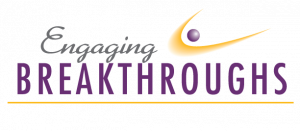Organizational Leadership: 6 Steps to Success

At Engaging Breakthroughs, we support the development of strong organizational leadership to maximize team performance and scalability. Our Unstoppable Teams program transforms teams by empowering individuals as well as the group as a whole. When we break through communication barriers and create more effective work environments, teams are able to maximize efficiency and reach challenging goals.
Because this is so important in today’s work environment, we’ve architected a powerful step-by-step process to foster healthy organizational leadership. Here are the big steps!
Organizational Leadership: Step 1
Acknowledge there’s a problem or something you want to be different.
Pay attention and recognize there’s discontent or longing with the status quo. In other words, identify that you want something to be different about the way the team operates. Get clear on what you currently want, but don’t have. For example, maybe your team:
- Underperforms on key organizational metrics
- Backstabs each other
- Fails to make bonus
- Complains to leaders instead of resolving issues independently
If you’re not sure whether your team is in need of change, here’s a resource to help you know whether your team dynamics are healthy. If everything is going well, that’s fantastic! But if not, whatever the problem may be, a strong organizational leadership culture will begin to resolve it.
Organizational Leadership: Step 2
Determine criteria for measuring the team’s current performance.
There are many organizational leadership models to choose from. Pick the model you want to use, and follow it through. At Engaging Breakthroughs, we believe Patrick Lencione’s The 5 Dysfunctions of a Team provides an effective model with strong criteria to measure team performance. These criteria include:
-
- Is the team leading with vulnerability-based trust?
- Hint: you can tell this is struggling if team members don’t ask each other for help
- Does the team engage in productive conflict?
- Do team members show commitment to decisions?
- Does the team hold each other accountable?
- Is the team focused on results?
- Is the team leading with vulnerability-based trust?
We believe these criteria provide an effective launch pad to determine our as-is and to-be status. When it’s time to scale and perform at a high level, these core elements empower teams to excel.
Organizational Leadership: Step 3
Assess the team based on your chosen criteria.
Once you have a model in place, you have an opportunity to assess the status quo. Next, assess the team based on the criteria. Here are some of the ways we do that in our Unstoppable Teams program:
-
- We gather an anonymous survey. This allows team members to speak freely about how they think they’re doing within the framework of the criteria.
- We guide the group to talk about how their team works together. Get the team to talk about their perception of their performance against the criteria. Team cohesiveness tends to be higher when members talk openly about what’s happening within the team. This is the first step of authentic engagement. Our expert facilitation creates a safe environment where people can open up about topics they often avoid.
Organizational Leadership: Step 4
Get buy-in.
In our employee engagement workshop, we initiate team members into seeing their team interaction in a new way. We first present a fresh idea of leadership communication. Then, we show the team how it benefits them in a way that makes sense. Here are some of the ways we do that:
-
- We facilitate practice communication that creates trust through vulnerability. For instance, teams engage in a new check-in process during the work week. In this process, leaders check in and acknowledge that they don’t know everything. They recognize they may have made a mistake, or that they need some help. Walls begin to crumble as team members open up and express themselves in new ways.
- We teach a model of emotional intelligence that introduces new ways of being that the team may want to develop. The model, which draws on TalentSmart principles, promotes higher levels of:
- Self awareness: Being aware of my emotions
- Self management: The choices I make in light of my emotions
- Social Awareness: Being aware of what others are feeling
- Relationship Management: The choices I make in light of others’ emotions
Organizational Leadership: Step 5
Support conversations that really matter.
While we know the importance of communication at work, few resources show how to do it effectively. That’s why we introduce a model that guides team members through tough conversations.
We draw on the proven Clean Talk model, introduced by Cliff Barry in the late 1980s. This model effectively supports organizational leadership driven by emotional intelligence and vulnerability-based trust. Using this model, teams:
- Practice resolving conflicts that hold the team back
- Learn to show up powerfully and get more of they want from others, including other team members, colleagues and leaders outside of the team, and outside vendors
Effective teams talk. When teams can talk about the data, their judgments, the stories they see and tell, and their emotions, they open up. Moreover, when they know how to clear things up with colleagues, it changes the entire group dynamic.
Organizational Leadership: Step 6
Integrate.
Now that the team has new tools, it’s time to use them to build a new normal. By nature, many new practices will stick because they prove themselves to be effective. However, teams will not be transformed without a cautious eye to integration. Bad habits are hard to break, and it’s difficult to make good habits stick. Some of the ways we facilitate integration include:
- The 20/200 rule, which tells us we must practice something new 20 times before it starts feeling comfortable, and 200 times for it to become a habit
- The flourish model, which helps people reach 200 repetitions by defining the 4 keys that support a lasting new behavior. This model brings a more practical approach to developing desired behaviors, other than to “just do it.” It emphasizes the essential concepts of ongoing support and connecting to your deeper purpose.
- Reinforcing embodiment, which allows the team to create a vision of the future and bring it into reality.
Integration is what meaningfully changes team culture. That is, when someone connects their deeper purpose to the team and the company, we transform the team environment. This is what brings organizational leadership to a new level. In this space, people and processes come together to create powerful results.
Complimentary Consultation for Organizational Leadership
I’d love to visit with you to discuss how our organizational leadership program can help your team break through barriers, perform at a high level, and scale with ease. We offer solutions that empower teams to reach new heights. To learn more, schedule a complimentary online Unstoppable Teams consultation via Zoom.
In this 30-60 minute online breakthrough coaching session, I will help you get crystal clear on where you are right now and where you want to be. I’ll give you my best professional recommendations to help you take your first steps toward your success breakthrough.
Click here to book your session now.
 |
Written by Craig Tennant Founder, Engaging Breakthroughs Transformation Architect and Breakthrough Coach At Engaging Breakthroughs, Craig Tennant delivers breakthrough success workshops and online life coaching to increase emotional intelligence. He offers proven leadership development for leaders who seek to build effective teams, break through to success in their careers, and discover life beyond the 9 to 5. |
